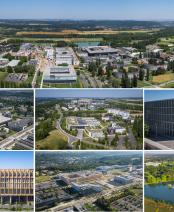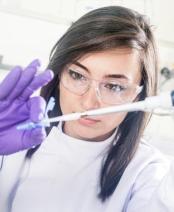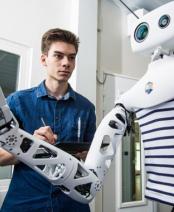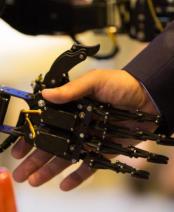The sciences of photovoltaics
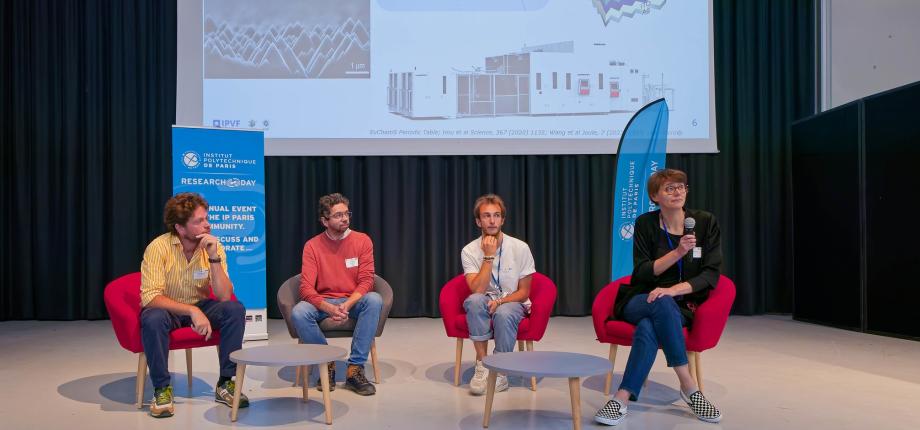
Palaiseau, an October morning. Autumnal gloom and rain. Quite a paradox when it comes to visiting the Institut Photovoltaïque d’Île-de-France (IPVF1). And yet, the weather is a reminder that, beyond the physics of light, photovoltaics calls for numerous fields of research. Like surface chemistry, in which Nathanaelle Schneider is a specialist, and more specifically Atomic Layer Deposition (ALD), a technique developed some fifty years ago to cover objects with a layer of material 100,000 times thinner than a sheet of paper (in the nanometer range). “It involves spraying specific compounds - molecular precursors - onto a surface to trigger a chemical reaction that results in the formation of an atomic layer. This is repeated as many times as necessary, leading to the production of a thin layer whose thickness can be controlled at the atomic level”, explains the CNRS researcher.
Barrier layer
Nathanaelle Schneider applies ALD to photovoltaic cells with the aim of protecting them (see “Encapsulating for better protection” text box) and/or improving their performance (conversion efficiency, use of abundant elements, etc.). Today's cells are composed of stacked layers of semiconductors. This arrangement enables the creation of an electric field at the junction zone, and the circulation of electrons generated by the absorption of photons. “For example, semiconductors have surface defects where charges can recombine. This means they no longer contribute to photovoltaic conversion, and the cell's yield decreases,” explains Nathanaelle Schneider. “By conforming perfectly to the surfaces it covers, ALD makes it possible to manufacture coatings that compensate for this phenomenon. This is all the more interesting as the trend is towards the multiplication of materials and interfaces, as in the case of tandem silicon-perovskite cells”.
In this context, the scientist is looking for the right chemistry and the right process to achieve the desired function, in this case passivation. Conversely, and on a more fundamental level, Nathanaelle Schneider can characterize a promising molecule and determine whether applications are possible in photovoltaics or other fields. “For example, I study molecular precursors for ALD, working closely with colleagues at the Laboratoire de Chimie Moléculaire (LCM2) of École Polytechnique. I observe the functions and properties that the material acquires as it grows, using optical measuring instruments developed at the IPVF (absorption properties, conductivity, thickness, etc.)”. The stakes are high, given that perovskite crystals cannot withstand temperatures in excess of 100°C, and that current layer deposition protocols flirt with 500°C. A further challenge: the lifespan of photovoltaic panels is set at 20 years, and researchers are aiming to deploy the silicon-perovskite tandem on large surfaces (40 cm * 60 cm).
Electron relaxation and high efficiency
Complementing chemistry, physics is one of the other avenues explored by researchers to develop more efficient photovoltaic panels. Through the prism of thermodynamics, Daniel Suchet analyzes and characterizes certain physical phenomena at play in the conversion of solar energy into electricity and explores possible strategies. Light-matter interactions are part of his daily routine, particularly in hot carriers. “These are materials whose electrons have been excited by an optical process or by light. The electrons have then received an excess of energy that they have not had time to dissipate by exchanging heat with their environment”, explains the assistant professor at the École Polytechnique and deputy scientific director at the interdisciplinary Energy 4 Climate Center.
By examining the light re-emitted by these materials (photoluminescence analysis), the physicist is seeking to understand the dynamics of electron relaxation (editor's note: the return of an excited electron to a lower energy level, accompanied by the emission of a photon), an essential prerequisite for new perspectives in photovoltaics. “Indeed, this excess energy is potentially recoverable and transformable into electrical power. This opens up the possibility of developing highly efficient photovoltaic cells”.
The same analytical method is applied to the study of material degradation. By placing samples in an ageing chamber (extreme temperatures, humidity, UV, etc.), the researcher induces the appearance of defects. He can then observe the impact of these alterations on electron behavior, in real time, via analysis of electrical and photoluminescence measurements. The “acceleration” of time makes it possible to determine whether the observed degradations follow a classic trajectory or change the mechanisms at work. “This is ideal for anticipating the evolution of new types of photovoltaic cells or new materials, particularly in non-compliant environments such as agricultural environments for agrivoltaics, or bodies of water for floating photovoltaics.”
Deploying and optimizing the use of photovoltaics
Such systems are being studied at the Institut Polytechnique de Paris, following the example of the SIRTA3 agrivoltaic platform and the future XSeaO2 platform planned for the École Polytechnique lake. “They are part of a series of six demonstrators planned for the Palaiseau campus. Through them, we're looking at how to massively deploy solar energy on a city or neighborhood scale, and testing solutions to better produce and consume the same energy. To do this, we use equipment that already exists in industry, as close as possible to the applications,” explains Jordi Badosa, research engineer at the Dynamic Meteorology Laboratory (LMD4) of
At SIRTA, for example, alfalfa grows in the “shadow” of photovoltaic panels. “Orientable and spaced further apart than usual, they can protect crops from the vagaries of the weather (drought, hail, etc.) and, in accordance with current legislation, are first and foremost at the service of the plant (priority to agriculture)”. Instruments scattered across the cultivated plot return data from the soil, panels and alfalfa. “Analysis of the data reveals that the panels offer the plant greater resilience,” says the research director. He is also working on the device's control algorithm, to make it intelligent and predict the best possible inclination of the panels according to agricultural needs and the weather.
Work on managing the distribution and consumption of photovoltaic energy is also being carried out in the École Polytechnique Bachelors building. Thanks to a dedicated application, the building's 500 users can play an active role in the site's energy consumption and environmental impact. Students living in the building can, for example, manage the temperature of their radiators remotely, according to their timetable. In addition, the basement houses 10 recharging stations, for experimental purposes, for users of the campus's electric vehicles. “Still on the subject of buildings, we are launching a demonstrator in which the surplus energy produced in summer by the solar panels installed will be stored underground, 200 m below ground, in the form of heat. Heat pumps will release this energy in winter for heating purposes”, enthuses the researcher.
Even on water
Water, too, is about to be conquered by photovoltaics. With the XSeaO2 platform, solar panels will soon be deployed on the École Polytechnique lake. They will power a device that produces synthetic fuel from the CO2 and hydrogen contained in water. As the CO2 emitted by the fuel is redissolved in the lake, the system will be close to carbon neutrality. Research teams at the E4C center (LCM, LMD, UCP5) will shortly be launching the proof-of-concept phase. Proof, if proof were needed, of the many facets of photovoltaics.
About :
Jordi Badosa is Technical Director of the interdisciplinary Energy4Climate center within the Dynamic Meteorology Laboratory (LMD) at the École polytechnique.
After completing his doctorate in atmospheric physics, Jordi Badosa joined the Dynamic Meteorology Laboratory (LMD) at the Ecole Polytechnique in 2010, where he developed photovoltaic forecasts for solar production storage management applications. Since 2019, he has been the technical director of the interdisciplinary Energy4Climate center (https://www.e4c.ip-paris.fr/#/en/). His current research topics are solar energy forecasting, characterization and modeling of outdoor photovoltaics, and local-scale energy management (mainly photovoltaics with storage). He conducts his research in the context of interdisciplinary collaborations. Jordi Badosa has coordinated 5 demonstrator projects at the IP Paris Campus since 2015.
>> Jordi Badosa on ResearchGate
Nathanaelle Schneider is a chemist and CNRS researcher at the Institut Photovoltaïque d'Ile-de-France (IPVF).
Nathanaëlle Schneider works on the synthesis of new materials by ALD (Atomic Layer Deposition) for photovoltaic applications. Using coordination chemistry in particular, her research has led to new methodological approaches for the design of ALD precursors, material solutions for certain photovoltaic devices and new functional materials for which UMR-IPVF is now a recognized world pioneer. In 2020, it was awarded the CNRS bronze medal.
>> Nathanaelle Schneider on ResearchGate
Daniel Suchet is an assistant professor in the physics department of the École polytechnique and at the Institut du Photovoltaïque d'Ile de France (IPVF). He is also deputy scientific director of the interdisciplinary Energy4Climate (E4C) center.
Previously, ingénieur de l'Ecole polytechnique (X2008), Master's degree in Quantum Physics from the Ecole Normale Supérieure de Paris, PhD thesis at Laboratoire Kastler Brossel, JSPS Fellowship at RCAST (University of Tokyo), ANR Industrial Chair postdoc at the Laboratoire de Physique des Interfaces et des Couches Minces (Ecole polytechnique).
Member of the executive committee of the International Tournament of Physicists (IPT), editor-in-chief of the educational journal Emergent Scientist, member of the Youth Commission of the French Physical Society.
Scientific mediation: conferences for the general public (“Comment parler de Science avec de la Fiction?”, “Energie et société”), Fête de la Science Ambassador for the Île de France region (2018).
>> Daniel Suchet on ResearchGate
Aubin Parmentier, PhD student, Institut photovoltaïque d'Île-de-France (IPVF), a joint research unit of CNRS, École polytechnique, ENSCP, IPVF SAS, Institut Polytechnique de Paris.
In March 2023, Aubin Parmentier was one of 10 IP Paris finalists selected for the regional final of the Ma Thèse en 180 secondes competition with his topic - “Encapsulation of solar cells by the ALD (Atomic Layer Deposition) thin-film deposition method”.
1IPVF: a joint research unit CNRS, École polytechnique, ENSCP, IPVF SAS, Institut Polytechnique de Paris, 91120 Palaiseau, France
2LCM: a joint research unit CNRS, École Polytechnique, Institut Polytechnique de Paris, 91120 Palaiseau, France
3SIRTA: Site instrumental de recherche par télédétection atmosphérique de l'Institut Pierre Simon Laplace (Instrumental site for atmospheric remote sensing research at the Pierre Simon Laplace Institute)
4LMD: a joint research unit CNRS, ENS - PSL, Sorbonne Université, École Polytechnique, Institut Polytechnique de Paris, 91120 Palaiseau, France
5UCP: a research lab ENSTA Paris, Institut Polytechnique de Paris, 91120 Palaiseau, France









